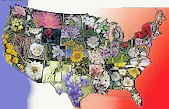
Texas Symbols
Texas State Flower
Bluebonnet

(Lupinus subcarnosus)
(Lupinus texensis)
Adopted: on March 7, 1901
The bluebonnet was designated the official state flower of Texas in 1901. Also called buffalo clover, wolf flower, and el conejo (spanish for "the rabbit" by the Mexicans), bluebonnets are to Texas what the shamrock is to Ireland. Adopted {Bluebonnet (Lupinus subcarnosus)} on March 7, 1901. Amended on March 8, 1971 to include L. texensis and "any other variety of bluebonnet not heretofore recorded" (there are at least four other species of bluebonnet growing in Texas: L. havardii, L. concinnus, L. perennis, and L. plattensis). L. texensis and L. subcarnosus are native to Texas.
Texas State Flower: Bluebonnet

Bluebonnets have long been a favorite of Texans. Historian Jack Maguire refers to Texas' state flower as "an institution, almost as well known to outsiders as cowboy boots and the Stetson hat." Imagine if one of the other ideas the open cotton boll ("the white flower of commerce") or the flowering prickly pear, for instance - had won the nomination. The Society of Colonial Dames of Texas vigorously lobbied for the obvious choice. This only began the long list of official bluebonnet designations.
Since this flower has look-alike "cousins," the state legislature, in 1971, named all lupine species as the official state flower. On March 8, 1971, Texas Legislators decided that the official Texas flower should not exclude the showier and more prolific Lupinus texensis. Just to make sure, the new state flower resolution included "any other variety of bluebonnet not heretofore recorded." This means that the six species of bluebonnets native to Texas are considered the state flower. It seems fitting that Texas also has six flags in its history.
One of the most beloved wildflower advocates made her voice heard when her husband, Lyndon B. Johnson, became president in 1963. Lady Bird Johnson, just two years later, along with Secretary of the Interior Stewart Udall, a group of philanthropists, designers, publishers, other officials and civic leaders formed the Committee for a More Beautiful Capital. This was Lady Bird Johnson's first contribution to the "Keep America Beautiful" campaign. On her 70th birthday, December 1982, Lady Bird celebrated by donating 60 acres of land on the Colorado River near Austin and the funding needed to found the National Wildflower Research Center. Now called the Lady Bird Johnson Wildflower Center, she stated the goal of the center is "to educate people about the environmental necessity, economic values and natural beauty of native plants."
In west Texas, the tall Big Bend bluebonnet grows up to three feet high . The shorter, more common Texas Bluebonnet, grows east of a line going from northeast to southwest Texas. It reaches a height of 15 to 24 inches, and blooms from early March to early May. Named for its color and, it is said, the resemblance of its petal to a woman's sunbonnet, the bluebonnet is the state flower of Texas. It blooms in the early spring and can be readily found in fields and along the roadsides throughout central and south Texas. After it rains, look for a drop of water in each bonnet or bowl-like petal. As the Texas bluebonnet flower ages, one of the top petals turns purple-red.
Blooms: March through May.
This flower is part of the Legume family.
Texas House Concurrent Resolution
(Lupinus subcarnosus)
Added by Senate Concurrent Resolution No. 10, 27th Legislature, Regular Session (1901)
(Lupinus texensis)
Added by House Concurrent Resolution No. 44, 62nd Legislature, Regular Session (1971)
Texas House Concurrent Resolution No. 44
Addressing the issue in 1971 by concurrent resolution, approved on March 8, 1971, to include Lupinus Texensis and, gun-shy, " any other variety of bluebonnet not heretofore recorded."
OFFICIAL STATE FLOWER
H. C. R. No. 44
WHEREAS, The Lupinus Texensis is considered the most beautiful species of bluebonnet and is to be found almost anywhere in the fields and along the
highways of Texas; and
WHEREAS, Other varieties of bluebonnet also grow in the state, among them the Lupinus Subcarnosus, which was named State Flower of Texas by the 27th
Legislature on March 7, 1901, at the request of the Colonial Dames in Texas; and
WHEREAS, Mrs. Robert Ward Cutler, Texas Goodwill Ambassador by appointment of the Governor of Texas, with the cooperation of the National Society
of the Colonial Dames of America in the State of Texas has asked this 62nd Legislature, 70 years after the bluebonnet was selected as official state
flower, to include the Lupinus Texensis and any other variety of bluebonnet not heretofore recorded along with the Lupinus Subcarnosus for recognition
as the official state flower of Texas; now, therefore, be it
RESOLVED by the House of Representatives of the State of Texas, the Senate concurring, That the Lupinus Texensis and any other variety of bluebonnet
not heretofore recorded be recognized along with the Lupinus Subearnosus as the official state flower of the State of Texas.
Adopted by the House on February 24, 1971; adopted by the Senate on March 1, 1971.
Filed with the Secretary of State, March 8, 1971.
Essentially, all bluebonnets found in Texas are now considered the official flower of the state.
The Texas Statutes
The law designating thebluebonnet as the official Texas state flower is found in the Texas Statutes, Government Code, Title 11, Chapter 3101, Section 3101.008.
GOVERNMENT CODE.
TITLE 11. STATE SYMBOLS AND HONORS; PRESERVATION.
CHAPTER 3101.
SECTION 3101.008.
§ 3101.008. STATE FLOWER. The state flower is the bluebonnet.
Added by Acts 2001, 77th Leg., ch. 1420, § 7.001, eff. Sept. 1, 2001.
Taxonomic Hierarchy: Bluebonnet
Kingdom: Plantae - Plants
Subkingdom: Tracheobionta - Vascular plants
Superdivision: Spermatophyta - Seed plants
Division: Magnoliophyta - Flowering plants
Class: Magnoliopsida - Dicotyledons
Subclass: Rosidae -
Order: Fabales -
Family: Fabaceae - Pea family
Genus: Lupinus L. - lupine
Species: Lupinus subcarnosus Hook. - Texas bluebonnet
Lupinus texensis Hook. - Texas lupine
State Floral Emblems







